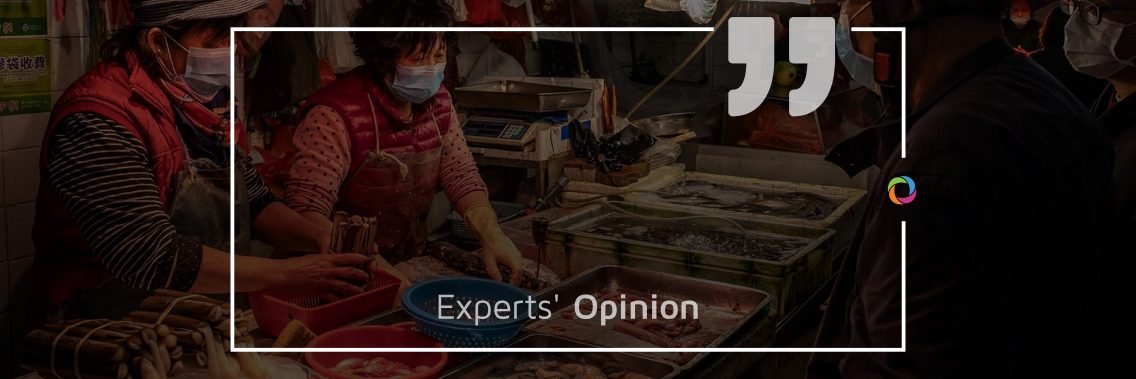Covid-19 and the SARS outbreak of 2003 have two things in common, both are from the coronavirus family and both have been associated with animals commonly sold in “wet markets.” Wet markets are prevalent in Asia, Africa and elsewhere, selling fresh fruit and vegetables, poultry, fresh meat, live animals and sometimes wildlife.
Peter Maro is a dedicated Medical Doctor with over 16 years of experience and Elizabeth Alderson has spent over 25 years working in agricultural development projects in Africa, Asia and South America. Let’s see what they have to say regarding wet markets.
How widespread are such wet markets in different parts of the world and which animals are most commonly found at these markets?

“Every morning as the sun rises, “wet markets” in China, South Asia and other parts of the world come to life with stall holders peddling commodities such as fresh meat, fish, fruit and vegetables, herbs and spices in an outdoor setting. These markets are frequent destinations for many Chinese people as places to shop, walk and chat with friends and neighbors and they form an essential part of Chinese life – and establish a safe and affordable source of food. The markets have kept a traditional way of life, well-preserved against modernization, as a platform for regional variety and culture and as a unique way for customers to access non-processed foods, whatever their income level. The wet markets can be compared to European farmers’ markets and are simply places that offer a broad range of fresh produce. Some, but not all, also sell live animals and wild animals. The Chinese government has temporarily banned all trade in wild animals for food and has issued a new draft list of livestock that can be farmed for meat.”

“Wet markets are common throughout the tropical and sub-tropical world, predominantly in Asia, but also in Africa and South America, where they are preferred for their prices, freshness of food, social interaction and local culture and play critical roles in urban food security. Live poultry markets selling mostly chicken, pigeon, quail, ducks, geese, and a wide range of exotic wild and farm reared birds are usually but not always separated from those selling fish or red-meat animals. Often wet markets sell and slaughter live animals on site.”
What are the main dangers of these markets?

“Wet markets offer a platform where humans come into contact with animals, where an exchange between humans and food animals occurs. This exchange offers a conceivable chance for infection to jump from animals to humans. Additionally, the diversity of animals that are sold in wet markets provides further risk as they bring in different species of microbes to the same location. Furthermore, the World Health Organization (WHO), while highlighting the importance of wet markets for the survival of some populations, also acknowledges the existing risks posed by the markets and emphasizes that many places are poorly controlled and inadequately maintained.”

“The buying, selling and slaughtering of animals for food in unhygienic conditions can cause the transmission of pathogenic animal-borne diseases to humans, known as zoonosis. Animals sold in wet markets are often unhealthy and kept in dirty, cramped conditions such as in stacked cages. Where animals are under stress, viral pathogens can intermingle and mutate making them more transmissible between species. Many food vendors in wet markets are not aware of the public health and food safety standards necessary to maintain good hygiene while distributing food. Insanitary conditions for processing and storage of food products, a lack of vendor access to clean water and inappropriate disposal of animal fluid including blood and faeces, encourage the proliferation of pathogens, leading to heightened risks of foodborne diseases. In the case of respiratory diseases such as COVID-19, the virus can jump to food handlers or customers through exposure to an animal’s bodily fluids. Close interaction with wild animals has caused numerous disease outbreaks in humans, such as Ebola, Avian Influenza, SARS and HIV.”
Do you have any suggestions regarding these wet markets?

“Wet markets are not only a source of affordable food and a place to chat with friends and neighbors, they also play a vital role in preserving the culture of an area. Two wet markets in China are suspected as being the primary source of the spread of two outbreaks of severe coronavirus respiratory infections. The dangerous and unsanitary practices of the wet markets likely spawned the unfolding of the outbreaks and a Wuhan wet market, offering live wild animals for sale, may have been the origin of the COVID-19 virus. Since there is a strong link between illegal wildlife sold in wet markets and zoonotic diseases, it is clear that the wet markets are becoming a possible platform for the transmission of microbes from animals to humans, and some could potentially cause serious outbreaks. Additionally, it has been established that the majority of wet markets are poorly regulated with inadequate standards. In my opinion, regulating wet markets through the introduction and enforcement of agreed policies would be a fundamental step towards improving standards, cleanliness and a safer environment that, in turn, would prevent transmissions of zoonotic microbes.”

“The level of hygiene and food safety control in the food industry has been greatly improved worldwide by the implementation of the global hazards analysis and critical control points programme (HACCP). To help prevent the spread of food-related pathogens and diseases in wet markets, statutory Food Health and Safety regulations using the HACCP model need to be implemented and enforced by local governments to regulate food safety standards. Both vendors and consumers need to be educated to recognize the importance of food hygiene and safety in disease prevention and control. Initiatives to improve food safety in developing countries by trading in a clean and safe environment can generate opportunities to support locally produced food for producers and consumers. Assistance from international programs to implement training courses in international hygiene and food safety standards for vendors in wet markets with course completion certificates followed up by regular inspections from local authorities could help to improve awareness of the need for global food safety and hygiene.”
Check more than 590 job opportunities in health and livestock here.

